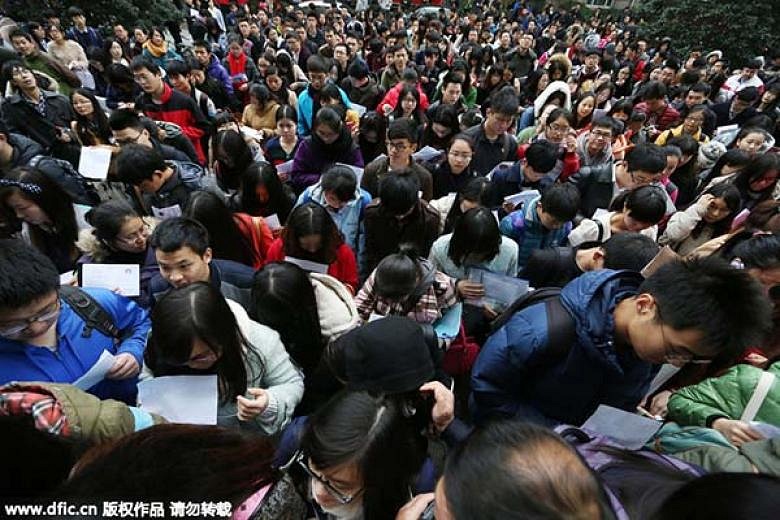BEIJING (CHINA DAILY/ ASIA NEWS NETWORK) - Guokao, or China's national civil service exam, will take place on Sunday (Nov 27). It is China's national level exam to enrol government employees. It attracts a large number of candidates each year because government jobs, dubbed "iron rice bowls", mean guaranteed job security, steady income and benefits.
If you think your college exam was tough, then brace yourself for this. If you think your high school exam was nerve-racking, then this would make you sweat from every part of your body.
It's China's national civil service exam, or guokao. The exam, which will be held across the country this Sunday, attracts a large number of candidates each year because the government jobs, dubbed "iron rice bowls", mean guaranteed job security, steady income and benefits.
There are 135 multiple-choice questions that candidates have to answer in two hours, which means there's less than a minute to answer each question. But that's not all. The questions cover wide range of topics, including math, world affairs, language, and logic.
Now, before you start thinking that it doesn't sound that difficult, there's more. This is just one part. Apart from the multiple-choice test, there are three hours of essay writing.
All the tests are designed to comprehensively assess the candidates' abilities, including psychological potentials, ability to read, analyse and solve the problems.
So now that we have provided a taste of the test, how about dipping your toe into the actual thing? Here are some of the questions that civil servants slog through to get the coveted government job.
How about giving them a shot?
1.Observe the images below and pick out the right one that belongs to the blank or the group.

Hint: Each row has shared shapes. First row is round; second is triangle; third is quadrangle
Answer: B
2.Observe the images below and pick out the right one that belongs to the blank or the group.

Hint: From left to right, there're increasing numbers of small shapes in each image. 1. One round 2. Two quadrangles 3. Three candle-shaped images 4. Four trapezoids 5. Five triangles. The image with six small shapes will be the right answer.
Answer: A
3.Observe the images below and pick out the right one that belongs to the given group.

Hint: In the left, four images, it's the mirror image of number 1, 2, 3, 4. Hence we need to find the mirror image of 5.
Answer: C
4.Observe the images below and pick out the right one that belongs to the blank or the group.

Hint: Look at the image row by row from left to the right. The faces are turning 90 degrees one by one. Eyes are opposite from the first one to the second one on each row. The mouths are opposite from the second to the third on each row.
Answer: C
What about an analogy question?
5. Which one is the wrong match between the idioms and economic terms?
A. Spilt water cannot be gathered up again - Opportunity cost
B. One nation can't have two queens - Complete monopoly
C. Entering a room full of fragrant orchids and getting used to the sweet smell -- Diminishing marginal utility
D. When the city gate catches fire, the fish in the moat suffer -- Negative external effects
Hint: Match the meaning of the idioms and the economic terms.
Answer: A
Now let's see how well you know about history.
6. What is the possible situation that can happen?
A. Greeks watch World Cup in the stadium when the Revolution of 1911 happened
B. Chinese college students listen to radio by semiconductor receivers during the May 4th Movement
C. During the Cold War, a Soviet cinema shows a color movie
D. During the Vietnam War, Americans can surf the Internet on computers
Hint: You need to know about that period to make the call.
Answer: C
Are you already tired of all this? One last question to test if your instinct of language is good.
7. The Indian Ocean earthquake and tsunami showed humans the power of the nature. Although we have islands and submerged reefs as natural barriers to tsunamis, we need to be prepared for potential dangers. Sometimes the earthquake in the deep ocean does not cause any loss as the epicenter is far from the land, but the tsunami generated by the displacement of the water can cause huge damage. Tsunami waves can move at 800 km per hour in the ocean and can be several meters high. The main argument in the paragraph above is
A. Earthquakes and tsunamis warn people to pay attention to the ocean
B. Earthquakes and tsunamis in the Indian Ocean warn us to focus more on oceanography
C. Tsunamis generated by earthquakes can cause huge damages
D. Natural disaster is cruel
Answer: B
So, what was your final score? Were you able to crack some of the answers? If you got most of them right then you certainly deserve the "iron rice bowl". If you got few correct ones then start brushing up your knowledge by reading the papers every day. If you found all the questions hard then just blame the education system.

